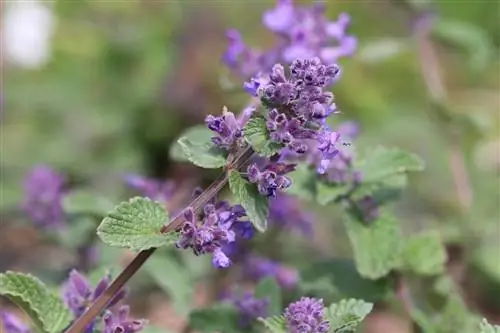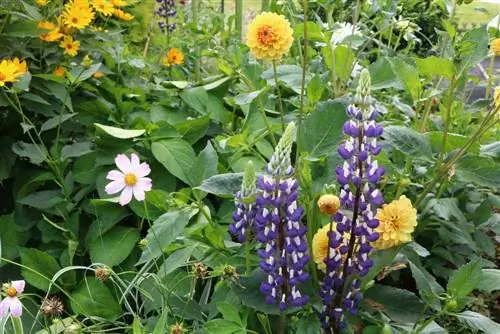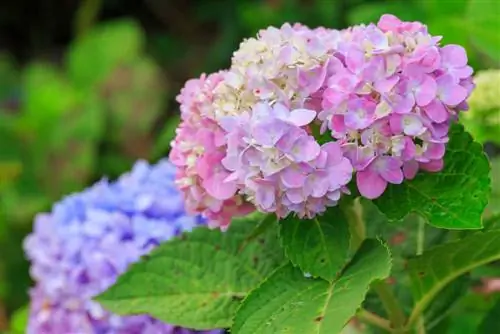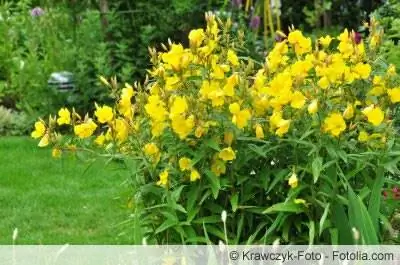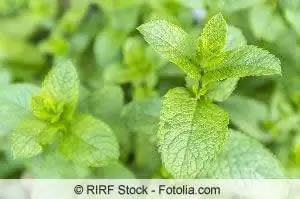- Author admin [email protected].
- Public 2023-12-17 03:39.
- Last modified 2025-06-01 06:48.
Catnip has the botanical name Nepeta cataria, is a member of the mint family and originally comes from Asia and Africa. The plant has also been growing wild in Central Europe for several centuries, where it is often found on roadsides and hedges. During the flowering period, the flower captivates with fragrant inflorescences and can bloom in different shades. The easy-care plant is ideal for herb and natural gardens and its spicy lemon scent attracts roaming cats, which decimate unwanted mice and rats.
Location & plant substrate
In a suitable location in the home garden, catnip will spread quickly and take on large dimensions. Due to its origins in warm countries, the Nepeta cataria loves sunny places and does not cope well with long-term shade. When it comes to soil in the garden and in the pot, the plant values a high nutrient content. The following aspects must be taken into account when considering the location and the planting substrate:
- Grows well in rockeries, cottage and wild gardens
- Prefers sunny to full sun conditions
- Avoid shady places
- Can also cope with difficult locations
- Suitable for container and garden keeping
- Well-drained and loose soil is ideal
- Constantly moist soils are not tolerated
- Sandy to loamy soil suits perfectly
- Optimal pH value: 6-7
Plants & Care
Planting and caring for catnip is relatively easy, the perennial does not have particularly high demands on its environment and also grows wild in the local latitudes. Since growth can quickly reach extraordinary proportions under optimal site conditions, it is important to ensure that there is sufficient planting distance. In the pot, the planting distance may be slightly smaller, as the planter represents a limiting barrier for growth:
- Easy-care, persistent and robust plant
- Hardy garden perennial for perennial gardens, can be used as a cut flower
- Plant either in a pot, in a balcony box or outdoors
- Prefers fresh soil that should not dry out too much
- Planting distance between individual perennials should be approx. 30 cm
- Apply between 3-8 plants per square meter
- Suitable for edging beds
- Plant tall-growing varieties in the background of the beds
Tip:
If the root ball can soak in a water bath before planting, it will be easier for it to grow in its new location.
Watering & Fertilizing
Catnip tolerates long dry periods relatively well and can survive for a certain period of time without additional watering. However, if the dry periods last longer, the perennial should be watered additionally. Catnip is also very undemanding when it comes to fertilizing, but extremely nutrient-poor soil should be worked up a little and made more nutrient-rich:
- Only water during long periods of drought
- Use a finger test to check the soil before watering
- Pour moderately, never pour too much
- Prevent waterlogging as this leads to root rot
- Additional fertilizer is rarely necessary, avoid over-fertilization
- Incorporate compost into nutrient-poor soil
Tip:
Leaves, flowers & growth
Catnip grows like a perennial and can grow to large sizes under suitable location conditions. The leaves and flowers exude a spicy scent and are used in medicine. They have an incredibly strong attraction for cats, which is where the name catnip comes from. The pets often roll around with their whole bodies in the shrub to acquire its scent:
- Perennial herbaceous perennial
- Growth height: 20-70 cm, in exceptional cases even up to 100 cm high
- Grey-green stems are branched, square and densely hairy
- Flowering period: July-September
- Flowers are approx. 7-10 mm long, long-tubed and two-lipped
- Flowers attract bees and bumblebees for pollination
- Flower crown is two-sided and symmetrical, white or purple
- Opposite, long-stemmed, hairy and coarsely toothed leaves
- Four-Part Split Fruits
- Used as a medicinal plant and as a tea plant
Cutting
If you want to extend the flowering period, you should prune the perennial. A limited pruning also prevents the catnip from spreading excessively on its own:
- First pruning in spring, after winter
- Prune the second time after the main flowering at the end of July
- Radical pruning possible down to a few centimeters above the ground
- Perennial sprouts again beautifully after cutting
- Do not prune from autumn onwards, stalks serve as winter protection
Wintering
Catnip is sufficiently hardy and can survive the local winters even without additional protection. However, the plant should no longer be pruned in autumn so that the pile left standing can serve as its own protection:
- Make sure to leave the stalks standing in the fall, as they provide sufficient winter protection
- Can survive long and extremely cold winters
- It always sprouts faithfully in spring
Propagate
There are various ways to propagate Nepeta cataria, which usually work without any problems. The perennial usually reproduces itself via its seeds and quickly spreads throughout the garden. In addition, catnip can be propagated via cuttings and root division if desired:
- Propagate by cuttings in April/May or in autumn
- Length of the cuttings: 7-10 cm, remove the lower leaves completely
- Let the cuttings root in the water glass, change the water repeatedly
- Divide the rootstock, ideally from April to June
- Carefully divide the root ball with secateurs or spade
- Water the root pieces sufficiently and replant them
- Sowing outdoors possible, germination time is 1-4 weeks
- Sprawling self-seeding, grows everywhere and quickly becomes annoying weeds
Tip:
In order to prevent catnip from spreading independently and over large areas, the seeds must be cut off completely before they are ripe and disposed of in the trash.
Diseases & Pests
Catnip is loved by cats, but most pests avoid the plant because of its essential oils. In addition, bees, bumblebees and butterflies like to romp around the flowers and visit them to pollinate. However, during periods of rainy weather, snail plagues can occur, which attack the young shoots and severely decimate the perennials:
- Diseases are almost unknown
- Snails often appear during wet weather conditions
- Collect snails regularly
- Covering plants overnight
- Spread slug pellets
Species
- Blue catnip (Nepeta x faassenii) - the best-known and most popular species. Wild perennial. Height 20 to 60cm and 80 to 120cm wide. Likes a sunny, warm location, likes in front of warm walls. Permeable light soil
- Large-flowered catnip (Nepeta grandiflora) - height 40-60cm. Blooms with pink inflorescences with very large flowers for the species
- Mussin's catnip (Nepeta mussinii) - wild perennial. Wild form of the catnip we know, which has its home in the Caucasus and Iran. Almost unavailable from us
- Grape catnip (Nepeta racemosa) - A very well-known species alongside blue catnip. Height 25cm. Blooms from May to September with small flowers in blue, white or purple on flower spikes
Varieties (selection)
- Dwan to Dusk: Large-flowered catnip. Height 60cm. Impresses with large flowers in pink
- Grog: Grape catnip. Impresses with striking purple-red calyxes and dark purple-blue flowers as well as a lemon-like scent
- Six Hills Giant: Blue Catnip. Height 50-60cm. Very popular variety with lavender blue flowers
- Snowflake: Grape catnip. Height 25cm. Grows very sprawling and is characterized by a snow-white sea of flowers
- Superba: Grape catnip. Height 25cm. Bushy clump-like growth. Produces deep lavender blue flowers from May to September
- Walkers Low: Blue catnip. Height 50-60cm. Flowers from June to September in violet-blue. Characterized by very long inflorescences covered with large flowers
Conclusion
Catnip is an easy-care and frost-hardy garden perennial that copes excellently with the local conditions. Nepeta cataria often feels too comfortable and sprouts wildly in the garden; catnip even finds a suitable location to grow in small cracks in the wall. However, self-sowing can cause nuisance to neighboring plants, which is why the perennial should be pruned before the seeds ripen. As the name suggests, cats are magically attracted to the scent of the flowers and leaves. In addition, the dried flowers and leaves also have a variety of uses in humane medicine.

